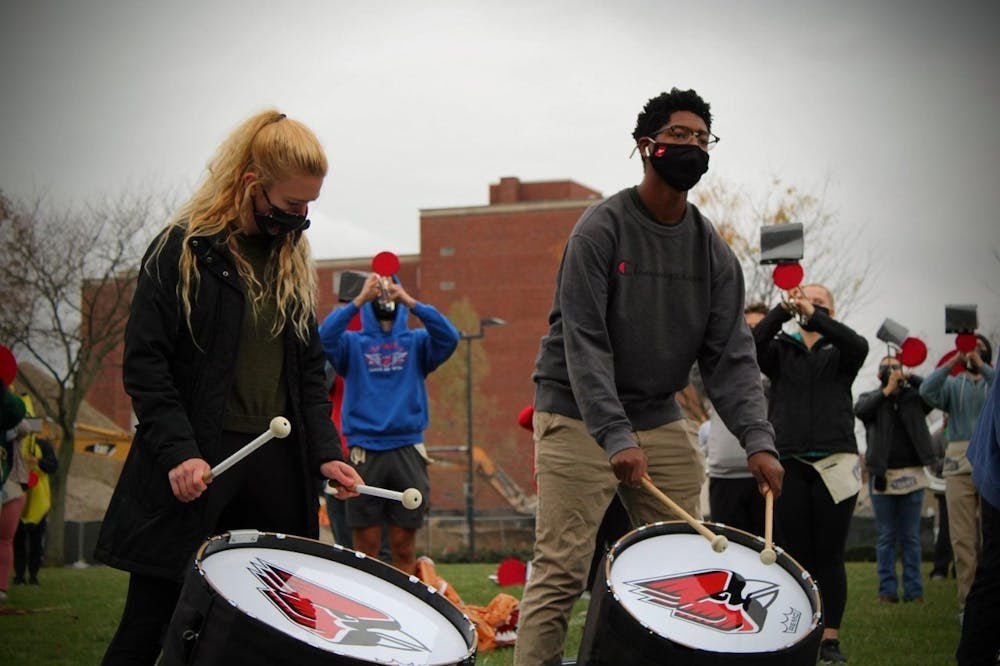Throughout the fall semester, sophomore music education major Aiden Cangany brought his trombone, music stand and sheet music to Ball State’s parking garages for a wide, open area to practice.
Performing in parking garages is one of several ways Ball State music students have adjusted their ways of practicing and performing this semester due to the COVID-19 pandemic.
“The way that using the parking garages helps is that it allows for a fairly open environment where we don't have to worry about leaving a room every 30 minutes because the air needs to circulate,” Cangany said. “The parking garages also surprisingly sound pretty good to play in. You get a nice echo.”
Ball State’s School of Music implemented new requirements this semester, such as students wearing face masks with mouth openings to stick their instrument’s mouthpiece through, placing coverings on their instruments’ bells and students wearing masks when they sing. Because of social distancing, students can’t perform in large ensembles, so directors have also chosen music that needs fewer musicians, and students participate in small, chamber music ensembles.
“Put all [these changes] together, it affects what [music] sounds like — it doesn't sound the same, but at least we're making music,” said Ryan Hourigan, director of Ball State’s School of Music. “The students are really resilient, and the faculty have been amazing in their flexibility.”
These changes were implemented in response to a study conducted this summer by major music organizations around the country to look at how aerosols spread through instruments and by voice. Hourigan said the study found that singing sprays aerosols more than playing instruments does.
Cangany said his School of Music classes have been divided into smaller sections where he and his classmates can either meet in person or participate in the class lecture on Zoom.
Aron Callard, first-year grad student, said he auditioned at Ball State a week before the school transitioned to virtual learning in March. Meeting new people has had its obstacles, Callard said, because he is new to Muncie, and he hasn’t been able to connect with the community in person.
As a teaching assistant in Jazz III, Callard said the safety precautions have also been a challenge for most students in his ensemble because it is hard for his students to hear each other while they are spaced out.
“My ensemble — it's a lot of younger kids, some freshmen, so they're not used to collegiate jazz band yet,” Callard said. “A lot of them are learning how to play in a collegiate jazz band while also not being able to hear their peers a lot.”
Chris Van Hof, assistant professor of music performance and trombone instructor, said it was difficult switching from in-person classes to remote instruction, and practicing with more than two people became “almost impossible.”
To adjust how he teaches during the pandemic, Van Hof said he requires his students to submit recordings of themselves playing their instruments. He said his students found a positive outcome within this experience because they are able to look back on their recordings and reflect on how they can improve.
Because many music professionals are not currently working, Van Hof said, they have more availability to students online. On Oct. 1, Van Hof’s students attended a two-hour virtual clinic with George Curran, the bass trombonist for the New York Philharmonic Orchestra. Van Hof said this would not have been possible before because it would have been costly to attend the clinic in person.
“I just am really impressed with the resolve and determination that our music students have,” Van Hof said. “Without complaining or eye rolling, they leave their [personal protective equipment] on, and they have adapted very quickly to new safety protocols. They're willing to bend as much as they need to in order to be safe and to still grow as artists, musicians, teachers, sound engineers and all the other programs that we offer here.”
Whitney Twigg, a fifth-year music education major studying vocal and instrumental music, said she has a different view of how the pandemic is affecting her schooling than most students. Twigg said she believes virtual learning is less stressful because it cut out her time traveling to campus.
“I've not had a week yet where my schedule has been the same as another week, and that's actually been OK for me because it's kept my interest,” Twigg said. “I'm not getting burnt out and tired of it.”
AnnaMarie Kelly, junior music education major and percussionist, said it was really difficult for her when she had to “throw away” all of her work when she couldn’t play in her final performances of the year last semester when students were sent home. Now, she focuses on the positives of the opportunity to have been on campus this semester.
“In coming back, there was this real sense of excitement even though it was going to be really different,” Kelly said. “I just wanted to be back on campus, and be in the proximity of the people I wanted to be around and hopefully create music in some way. That's what I love the most, and I really, really missed it over that quarantine period.”
Throughout the semester, Kelly said, her professors have challenged her in ways she never would have been challenged before, and she now has a much greater appreciation for being able to create music.
“I think that it has been an incredibly hard year for every single person, professors included,” Kelley said. “The students might blame it on the professors for it not seeming as normal as other years, but it can't be normal because it's not normal.”
Contact Iris Tello with comments at idtello@bsu.edu.





